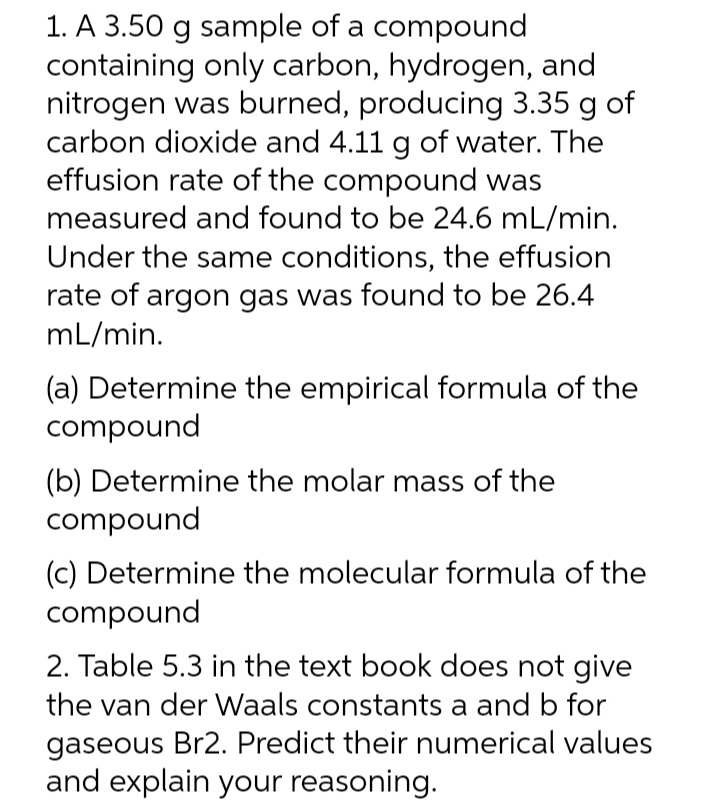1. A 3.50 g sample of a compound containing only carbon, hydrogen, and nitrogen was burned, producing 3.35 g of carbon dioxide and 4.11 g of water. The effusion rate of the compound was measured and found to be 24.6 mL/min. Under the same conditions, the effusion rate of argon gas was found to be 26.4 mL/min. (a) Determine the empirical formula of the compound (b) Determine the molar mass of the compound (c) Determine the molecular formula of the compound
1. A 3.50 g sample of a compound containing only carbon, hydrogen, and nitrogen was burned, producing 3.35 g of carbon dioxide and 4.11 g of water. The effusion rate of the compound was measured and found to be 24.6 mL/min. Under the same conditions, the effusion rate of argon gas was found to be 26.4 mL/min. (a) Determine the empirical formula of the compound (b) Determine the molar mass of the compound (c) Determine the molecular formula of the compound
Chemistry: An Atoms First Approach
2nd Edition
ISBN:9781305079243
Author:Steven S. Zumdahl, Susan A. Zumdahl
Publisher:Steven S. Zumdahl, Susan A. Zumdahl
Chapter8: Gases
Section: Chapter Questions
Problem 130AE
Related questions
Question
pls solve all parts with in 15 to 30 min

Transcribed Image Text:1. A 3.50 g sample of a compound
containing only carbon, hydrogen, and
nitrogen was burned, producing 3.35 g of
carbon dioxide and 4.11 g of water. The
effusion rate of the compound was
measured and found to be 24.6 mL/min.
Under the same conditions, the effusion
rate of argon gas was found to be 26.4
mL/min.
(a) Determine the empirical formula of the
compound
(b) Determine the molar mass of the
compound
(c) Determine the molecular formula of the
compound
2. Table 5.3 in the text book does not give
the van der Waals constants a and b for
gaseous Br2. Predict their numerical values
and explain your reasoning.
Expert Solution
This question has been solved!
Explore an expertly crafted, step-by-step solution for a thorough understanding of key concepts.
Step by step
Solved in 5 steps

Knowledge Booster
Learn more about
Need a deep-dive on the concept behind this application? Look no further. Learn more about this topic, chemistry and related others by exploring similar questions and additional content below.Recommended textbooks for you

Chemistry: An Atoms First Approach
Chemistry
ISBN:
9781305079243
Author:
Steven S. Zumdahl, Susan A. Zumdahl
Publisher:
Cengage Learning


Chemistry
Chemistry
ISBN:
9781305957404
Author:
Steven S. Zumdahl, Susan A. Zumdahl, Donald J. DeCoste
Publisher:
Cengage Learning

Chemistry: An Atoms First Approach
Chemistry
ISBN:
9781305079243
Author:
Steven S. Zumdahl, Susan A. Zumdahl
Publisher:
Cengage Learning


Chemistry
Chemistry
ISBN:
9781305957404
Author:
Steven S. Zumdahl, Susan A. Zumdahl, Donald J. DeCoste
Publisher:
Cengage Learning

General Chemistry - Standalone book (MindTap Cour…
Chemistry
ISBN:
9781305580343
Author:
Steven D. Gammon, Ebbing, Darrell Ebbing, Steven D., Darrell; Gammon, Darrell Ebbing; Steven D. Gammon, Darrell D.; Gammon, Ebbing; Steven D. Gammon; Darrell
Publisher:
Cengage Learning

Principles of Modern Chemistry
Chemistry
ISBN:
9781305079113
Author:
David W. Oxtoby, H. Pat Gillis, Laurie J. Butler
Publisher:
Cengage Learning

Chemistry: Principles and Practice
Chemistry
ISBN:
9780534420123
Author:
Daniel L. Reger, Scott R. Goode, David W. Ball, Edward Mercer
Publisher:
Cengage Learning